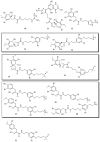New antimicrobial bromotyrosine analogues from the sponge Pseudoceratina purpurea and its predator Tylodina corticalis
- PMID: 25786066
- PMCID: PMC4377990
- DOI: 10.3390/md13031389
New antimicrobial bromotyrosine analogues from the sponge Pseudoceratina purpurea and its predator Tylodina corticalis
Abstract
Bioassay-guided fractionation of extracts from temperate Australian collections of the marine sponge Pseudoceratina purpurea resulted in the isolation and characterisation of two new and six known bromotyrosine-derived alkaloids with antibiotic activity. Surprisingly, a single specimen of the mollusc Tylodina corticalis, which was collected while feeding on P. purpurea, contained only a few of the compounds found in the sponge suggesting selective accumulation and chemical modification of sponge metabolites.
Figures







Similar articles
-
Bromotyrosine alkaloids from the Australian marine sponge Pseudoceratina verrucosa.J Nat Prod. 2013 Apr 26;76(4):516-23. doi: 10.1021/np300648d. Epub 2013 Mar 14. J Nat Prod. 2013. PMID: 23489291
-
Psammaplysin H, a new antimalarial bromotyrosine alkaloid from a marine sponge of the genus Pseudoceratina.Bioorg Med Chem Lett. 2011 Jan 15;21(2):846-8. doi: 10.1016/j.bmcl.2010.11.081. Epub 2010 Nov 21. Bioorg Med Chem Lett. 2011. PMID: 21190857
-
Ceratinadins E and F, New Bromotyrosine Alkaloids from an Okinawan Marine Sponge Pseudoceratina sp.Mar Drugs. 2018 Nov 23;16(12):463. doi: 10.3390/md16120463. Mar Drugs. 2018. PMID: 30477099 Free PMC article.
-
[Bromo- and iodo-containing alkaloids from marine microorganisms and sponges].Bioorg Khim. 2002 May-Jun;28(3):196-208. doi: 10.1023/a:1015748018820. Bioorg Khim. 2002. PMID: 12077845 Review. Russian.
-
Sequestration and possible role of dietary alkaloids in the sponge-feeding mollusk Tylodina perversa.Prog Mol Subcell Biol. 2006;43:261-75. doi: 10.1007/978-3-540-30880-5_12. Prog Mol Subcell Biol. 2006. PMID: 17153347 Review.
Cited by
-
Naturally Prefabricated Marine Biomaterials: Isolation and Applications of Flat Chitinous 3D Scaffolds from Ianthella labyrinthus (Demospongiae: Verongiida).Int J Mol Sci. 2019 Oct 15;20(20):5105. doi: 10.3390/ijms20205105. Int J Mol Sci. 2019. PMID: 31618840 Free PMC article.
-
Marine Bromotyrosine Derivatives in Spotlight: Bringing Discoveries and Biological Significance.Mar Drugs. 2024 Mar 14;22(3):132. doi: 10.3390/md22030132. Mar Drugs. 2024. PMID: 38535473 Free PMC article. Review.
-
Bisindole Alkaloids from a New Zealand Deep-Sea Marine Sponge Lamellomorpha strongylata.Mar Drugs. 2019 Dec 4;17(12):683. doi: 10.3390/md17120683. Mar Drugs. 2019. PMID: 31817295 Free PMC article.
-
An Anti-Inflammatory 2,4-Cyclized-3,4-Secospongian Diterpenoid and Furanoterpene-Related Metabolites of a Marine Sponge Spongia sp. from the Red Sea.Mar Drugs. 2021 Jan 16;19(1):38. doi: 10.3390/md19010038. Mar Drugs. 2021. PMID: 33467112 Free PMC article.
-
Purpuramine R, a New Bromotyrosine Isolated from Pseudoceratina cf. verrucosa Collected in the Kingdom of Tonga.Mar Drugs. 2025 Apr 27;23(5):186. doi: 10.3390/md23050186. Mar Drugs. 2025. PMID: 40422776 Free PMC article.
References
-
- Harper M.K., Bugni T.S., Copp B.R., James R.D., Lindsay B.S., Richardson A.D., Schnabel P.C., Tasdemir D., vanWagoner R.M., Verbitski S.M., et al. Introduction to the chemical ecology of marine natural products. In: McClintock J.B., Baker B.J., editors. Marine Chemical Ecology. CRC Press LLC; Boca Raton, FL, USA: 2001. pp. 3–69.
-
- Bergquist P.R., Wells R.J. Chemotaxonomy of the Porifera: The development and current status of the field. In: Scheuer P.J., editor. Marine Natural Products. Academic; New York, NY, USA: 1983.
-
- Bergquist P.R., Karuso P., Cambie R.C., Smith D.J. Sterol composition and classification of the Porifera. 3. Biochem. Syst. Ecol. 1991;19:17–24.
-
- Arabshahi L., Schmitz F.J. Brominated tyrosine metabolites from an unidentified sponge. J. Org. Chem. 1987;52:3584–3586.
-
- Teeyapant R., Kreis P., Wray V., Witte L., Proksch P. Brominated secondary compounds from the marine sponge Verongia aerophoba and the sponge feeding gastropod Tylodina perversa. Z. Naturforsch. C: Biosci. 1993;48:640–644. - PubMed
MeSH terms
Substances
LinkOut - more resources
Full Text Sources
Other Literature Sources

